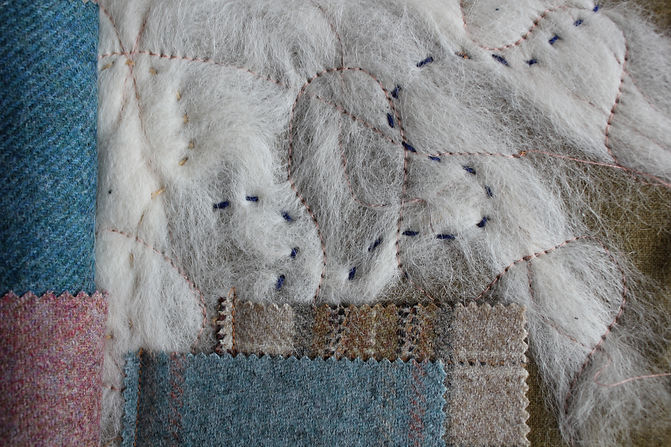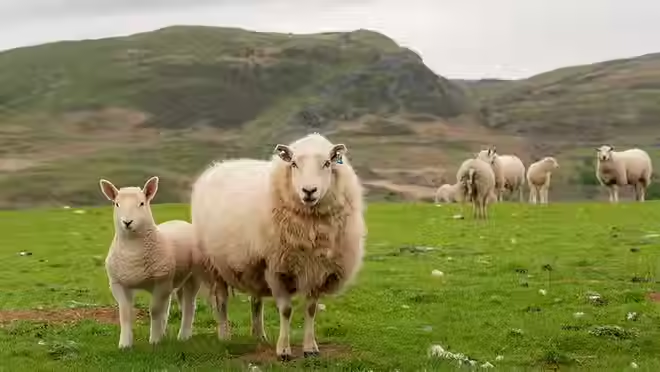
Wool
Wool is a fibre gathered from sheep or other animals. Camels, goats and rabbits also produce hair that is classified as wool. It is inherently flame resistant and is known for being warm and hard wearing, making it popular for use in public areas such as hotels, aircraft, hospitals and theatres. One of the biggest growers of wool is Australia, their wool is often imported to the UK and blended with British fibres. Australian wool farms are often passed down through families. These families live amongst nature and are aware of the importance of preserving the land for future generations. Many sheep are farmed on open grassy woodland, meaning that farming can be done in harmony with local wildlife. Wool is also the most reused and recycled fibre, it represents 5% of all clothing donated to charity and is one of the most sought after recycled textiles. Wool does not contribute to the microplastic and microfibre pollution crisis. All of this combines to make wool one of the more eco-friendly and sustainable fibres.
Pros to using wool
-
It’s completely biodegradable.
-
It’s natural.
-
Wool is renewable, sheep produce a new fleece every year.
-
Flame retardant.
-
Wrinkle resistant.
-
Can be treated in a range of ways to give it different properties.
-
Naturally breathable and soft.
-
Dyes well.
-
Easy to mould and tailor.
Cons to using wool
-
Can feel prickly
-
Felting and matting can be a problem
-
More expensive than synthetic fibres
-
Can often only be dry cleaned.
-
Can trap hair and dust.
-
Loved by moths.
-
Weakens when wet.

Production Process
-
Sheep are sheared once a year, usually in the springtime. And the fleece is kept in one piece as much as possible.
-
The fleece is graded on its overall quality and sorted, the best quality wool is generally from the shoulders and the sides of the sheep, with the poorer quality wool on the lower legs.
-
The raw wool is taken and put through a number of alkali baths in order to clean it. Lanolin is a by-product of this process and is often saved and used in a variety of other products.
-
Rollers are then used to squeeze most of the water out from the wool, which is sometimes coated in oil at this stage to make it more manageable.
-
The wool is then carded (passed through a series of metal teeth) and sorted into longer “worsted” and shorter “woolen” fibres. Carding removes any dirt or debris left in the wool after it has been washed.
-
The two different types of wool are then sent off separately to be spun into yarn.
-
The yarn is then woven into fabric, using most commonly a plain or a twill weave.
-
Finally the wool cloth is put through a series of finishing procedures which include:
-
Fulling- Submerging the fabric in water to make the fibres lock together.
-
Crabbing- Permanently setting this interlock.
-
Shrink proofing.
-
Dying (Although this can be done at a number of other stages in the production process)
History
Wool has been used since the domestication of sheep. Even before then the skins of sheep hunted for their meat were often used for clothing and to provide protection from the elements. Before the invention of the shears wool was often harvested using a comb or even just by plucking out the hair. Wool was treated by a fuller who would stamp on the wool in a barrel of old urine to produce a finer cloth. In medieval England wool was incredibly important, much of the wool produced was sold abroad and was responsible for a huge proportion of the British economy at the time. To this day the seat of the high chancellor in the house of lords is a large square bag of wool known as the “woolsack”, which serves as a reminder of the vital role wool played in the English middle ages. Wealth was often determined by the amount of sheep a landowner had. There were always traveling Flemish and Italian merchants in the wool markets looking to buy English wool. The chosen bales of wool were loaded onto pack animals and taken to English ports where they were shipped to Antwerp and Genoa. Over time larger land owners developed direct trading links abroad, this meant they were able to cut out the middleman and get a better price for their wool. However, peasants still had to rely on traveling wool merchants to buy their produce. The wool trade was taxed very heavily and these taxes went towards the funding of military endeavours. It is said that the hundred years war was started in part to protect Britain's wool trade links. The results of the hundred years war saw more wool cloth being produced locally in the UK, and many historic towns like lavenham were built on the success of the wool trade. In the 1570s to 1590s a law was passed that all English men had to wear a woolen cap to church on Sundays to help boost the wool trade. One of the major cities involved in the English wool trade was Leeds which was said to be built of wool. The canals running through Leeds and later the railway were both used as ways to export wool cloth from the city to be distributed all over the world.